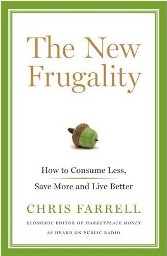
The New Frugality: How to Consume Less, Save More, and Live Better
by Chris Farrell
–Reviewed by Saskia Vogel
 Chris Farrell doesn’t write about numbers. He writes about living a good life in a decidedly retro way – The New Frugality is a redux of the old frugality.”The New Frugality means accepting the wisdom of always managing our finances with a ‘margin of safety,’” as he puts it.
Chris Farrell doesn’t write about numbers. He writes about living a good life in a decidedly retro way – The New Frugality is a redux of the old frugality.”The New Frugality means accepting the wisdom of always managing our finances with a ‘margin of safety,’” as he puts it.
“Our love affair with consumer debt is over,” Farrell writes, and we have the sub-prime mortgage crisis to thank for making living frugally more appealing than indulgence. And so it’s fitting that Farrell’s ideas aren’t exactly new, they’ve just been buried under mortgage payments and discarded consumer electronics.
Farrell, personal finance expert and economics editor of American Public Media, sets the tone for such suggestions when he goes to visit his ailing 83-year-old father, whose leg has been amputated in a recent and difficult surgery. Farrell’s reflections on his father, and his holistic approach to finance, give the book its heart. He sits at his bedside and reflects on the two wars his father fought in, the ups and downs of the economy he weathered, and the losses and joys of family life: “Through it all I never remember him succumbing to the dirge of the apocalypse popular during bursts or the siren song of the new era during booms. He wasn’t cheap. He wasn’t extravagant. He saved, took calculated risks, provided a home, educated his children, enjoyed his money, and gave back to the community. He lived ‘a good life.’”
Of course, the concept of the “good life” is laden with nostalgia for times past, though Farrell avoids idealizing it too much. From his tender, engaging anecdotes to brief explorations of American borrowing habits in the early days of the republic – where Farrell shows that Americans have always been borrowers – Farrell draws out basic and unchanging economic lessons: Invest in yourself through education and professional development. Worry about the downside. Borrow rarely and wisely. Give back. Think big. His advice is concrete – actionable tips on debt, risk, saving for college with a 529 plan, charitable giving, why we shouldn’t trust money managers as much as we do (they’re only as stable as the stock market they invest in), and more on how to live happily within your means.
He also translates into the old good life concept the new-ish sustainability trend, defining it as the mark of a healthy home economy. Drawing from the work of Saul Griffith on the science of climate change and sustainability, Farrell argues that a green home buys things to last, repairs things that break, commutes less and exercises more. Farrell’s message is simple but wise. Our fling with mass consumer culture, he hopes, is flung.
Excerpt: “Lending is an act of trust. The lender has to believe that the debtor will repay the loan. Borrowing is a strong statement of optimism. The borrower has faith that the future will be good enough for him or her to repay the debt. The American Dream is essentially a story of optimism. Immigrants come here to make a better life for themselves. Entrepreneurs believe customers will flock to their new business. Homeowners borrow enormous sums to buy a house convinced that tomorrow will be better than today. My dad was one of those optimistic borrowers when he bought his first home in Levittown, America’s most famous post-war suburb.”
Further Reading: Right on the Money!: Taking Control of Your Personal Finances by Chris Farrell and In Cheap We Trust by Lauren Weber.
Saskia Vogel is the publicity associate at Granta. Visit her at http://SaskiaVogel.com.
*Photo courtesy Thomas Hawk.




Send A Letter To the Editors